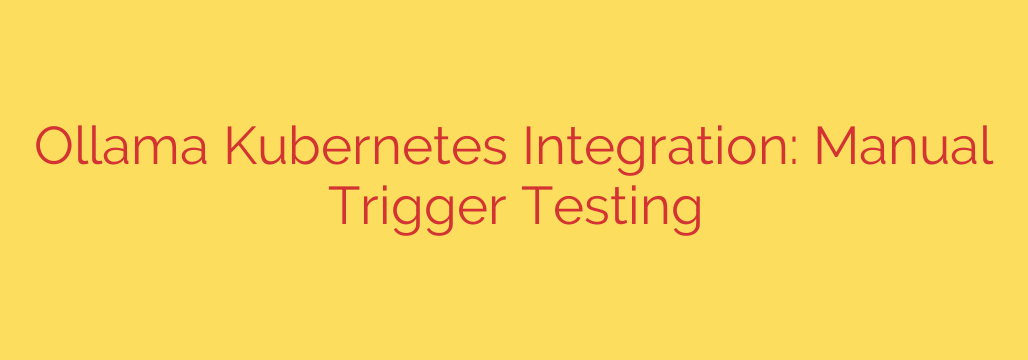
Mastering Your Ollama Deployment on Kubernetes: A Guide to Manual Testing
Running Large Language Models (LLMs) locally with tools like Ollama is a game-changer for developers and businesses focused on privacy, cost-efficiency, and customization. When you’re ready to scale these models and manage them in a production-grade environment, Kubernetes is the natural next step. However, deploying Ollama to a Kubernetes cluster is only half the battle. You must ensure it’s working correctly.
This guide provides a straightforward approach to manually testing your Ollama deployment within Kubernetes. This foundational verification process is critical for troubleshooting issues and building confidence in your setup before you move on to automating workflows or exposing the service to other applications.
Why Manually Test Your Kubernetes Deployment?
Before building complex applications on top of your Ollama service, you need to confirm that the core components are functioning as expected. Manual testing allows you to isolate the Ollama instance and verify several key aspects:
- Connectivity: Can the container reach the internet to download models?
- Storage: Is the persistent storage configured correctly to save downloaded models?
- Execution: Can the Ollama process load a model and perform inference successfully?
By confirming these basics, you can rule out foundational issues when debugging more complex problems later on.
Step-by-Step Guide to Testing Your Ollama Pod
The primary tool for this process is kubectl, the command-line interface for interacting with your Kubernetes cluster. The main goal is to gain access to the shell of the running Ollama container and execute commands directly.
1. Access the Ollama Pod
First, you need to identify your Ollama pod and open an interactive terminal session inside it.
Find your pod’s name by listing the pods in the relevant namespace:
kubectl get pods
Once you have the name (e.g., ollama-deployment-5dcf67c7f7-abcde), use the exec command to get a shell.
kubectl exec -it <your-ollama-pod-name> -- /bin/bash
If this command is successful, your terminal prompt will change, indicating you are now inside the container. This confirms your pod is running and accessible.
2. Test Model Downloads
A fresh Ollama deployment won’t have any models. The first functional test is to pull one. This verifies that your pod has the necessary network access to reach ollama.com and that its attached storage volume is writeable.
From inside the pod’s shell, run the pull command. We’ll use llama3, a popular and relatively small model, as an example.
ollama pull llama3
You should see a progress bar indicating that the model layers are being downloaded and extracted. A successful download confirms two critical things:
- Egress network connectivity is working.
- The persistent volume is correctly mounted and has write permissions.
If this step fails, you should investigate your cluster’s network policies, DNS configuration, or potential issues with your PersistentVolumeClaim (PVC).
3. Verify Model Inference
With a model successfully downloaded, the final step is to test its core function: inference. Use the ollama run command to interact with the model.
ollama run llama3 "Why is the sky blue? Explain it simply."
After a brief moment for the model to load, you should receive a coherent, AI-generated response directly in your terminal. This is the ultimate confirmation that your Ollama deployment is fully functional. It proves that the Ollama server process is running, can load a model into memory, and can utilize the pod’s allocated CPU or GPU resources to generate a response.
To exit the model’s interactive session, type /bye. To leave the pod’s shell entirely, type exit.
Common Troubleshooting Tips
If you encounter issues during this process, here are a few common areas to investigate:
- Pod Stuck in
Pending: This often points to resource constraints. Your cluster may not have enough available CPU, memory, or GPU resources to schedule the pod. Usekubectl describe pod <your-ollama-pod-name>to see detailed event logs. ollama pullFails: This is almost always a network issue. Check if your cluster has strict egress rules or if a NetworkPolicy is blocking outbound traffic from the pod. Also, verify that DNS resolution is working correctly from within the container.- Models Don’t Persist: If you have to re-download models every time the pod restarts, it indicates a storage problem. Ensure your Deployment manifest correctly defines a PersistentVolumeClaim and that the volume is properly mounted to the
/root/.ollamadirectory inside the container.
Important Security Considerations
When running services like Ollama in Kubernetes, always follow security best practices:
- Use Network Policies: Restrict ingress traffic to the Ollama pod so that only trusted applications within the cluster can access it. Avoid exposing the service directly to the public internet unless you have a secure gateway like an API Gateway or Ingress controller with authentication in front of it.
- Resource Quotas: Implement Kubernetes ResourceQuotas and LimitRanges to prevent your Ollama deployment from consuming excessive cluster resources, which could impact other critical services.
- Least Privilege: Configure your pod to run with the least privileges necessary. Avoid running the container as the root user if possible.
By performing these simple manual tests, you build a solid and reliable foundation for integrating powerful LLMs into your applications using the robust orchestration capabilities of Kubernetes.
Source: https://collabnix.com/test-manual-trigger-ollama-kubernetes-integration-2/








